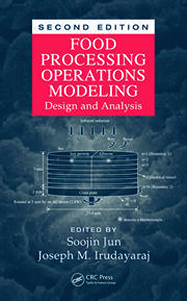Food Processing Operations Modeling Design and Analysis
Material type: TextLanguage: English Publication details: Boca Raton, FL : CRC Press, ©2009Edition: 2ndDescription: XII, 355 p. : illISBN:
TextLanguage: English Publication details: Boca Raton, FL : CRC Press, ©2009Edition: 2ndDescription: XII, 355 p. : illISBN: - 9781420055535
- 664.02 JUN
| Item type | Current library | Shelving location | Call number | Copy number | Status | Date due | Barcode |
|---|---|---|---|---|---|---|---|
 Reference Collection
Reference Collection
|
Seminar Library | Department of Food Engineering | 664.02 JUN | 2022-23 | Available | 98083 |
SUMMARY:
The food industry is on the verge of making some serious advances in the food processing sector. If successful, tomorrow’s consumers will have unhindered access to safe, nutritious, and high-quality products via novel food processing technologies. Food Processing Operations Modeling: Design and Analysis, Second Edition demonstrates how to effectively use numerical modeling to predict the effects of food processing on targeted components. This non-destructive testing method virtually eliminates the health risks of under-processed food and maintains high nutritional values that are often lost in overcooked food.
Using a task-oriented approach, this second edition discusses basic and advanced modeling tools that allow researchers to predict and prevent worse-case scenarios, perform comprehensive analyses, and optimize system design and efficiency.
Contains Selected Applications of Thermal and Non-Thermal Processing Operations
NEW TO THIS EDITION:
Six new chapters on radio frequency heating, high-pressure processing, pulsed electric field treatment, fouling model on heat exchangers, ozone treatment, and UV radiation
Expanded scope to address innovative and up-to-date food processing technologies
Numerous real-world case studies
Updated information on infrared heating of biological materials and modeling electrical resistance heating of foods
Electromagnetic treatments (RF, Infrared, and UV) and fundamentals relative to heat and mass transfer, fluid flow, and stochastic processes
Synergistic effect of combined food processing techniques and its numerical simulation
Food processing methods are constantly improving in an effort to maintain safe, high-quality, and fresh-tasting products. Providing the theoretical basis for these cutting-edge techniques, this tried-and-tested reference provides indispensable insight into food systems modeling, while exploring applications for further research.
